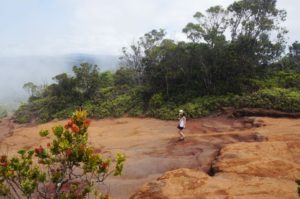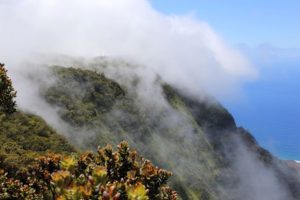 Seldom have I found a place where I have felt so completely at home and fulfilled as I have in Koke’e. The work in conservation biology and the people here have helped me reaffirm my desire to be involved in environmental science. It has also helped me to understand where I want to go in my future endeavors. I have received complete support from the Katie, Ellen and David which they displayed by showing an intense desire to teach me about the forest ecosystem and guide me in any way possible. When I arrived up on the mountain, I spent the first couple of weeks working out in the forest, just trying to identify the plants. This was no easy task considering that Hawaiian plant names are completely different than common names and usually consist of about one consonant and five vowels. I am still having trouble remembering the difference between A’ali’i, Ala’a , and Alahe’e. Despite the fact that my coworkers spoke about the overall ecosystem functioning, my energy was completely focused on the minute details of plant identification. I suppose now, looking back, that that was a good way to begin; it is important to build knowledge from the base up. I now have an understanding of the basic constituents of the mesic to wet forest here. However, it wasn’t until we took a four-day backpacking trip into Alakai swamp that the delicate balance between the plants and their environment really struck me.
Seldom have I found a place where I have felt so completely at home and fulfilled as I have in Koke’e. The work in conservation biology and the people here have helped me reaffirm my desire to be involved in environmental science. It has also helped me to understand where I want to go in my future endeavors. I have received complete support from the Katie, Ellen and David which they displayed by showing an intense desire to teach me about the forest ecosystem and guide me in any way possible. When I arrived up on the mountain, I spent the first couple of weeks working out in the forest, just trying to identify the plants. This was no easy task considering that Hawaiian plant names are completely different than common names and usually consist of about one consonant and five vowels. I am still having trouble remembering the difference between A’ali’i, Ala’a , and Alahe’e. Despite the fact that my coworkers spoke about the overall ecosystem functioning, my energy was completely focused on the minute details of plant identification. I suppose now, looking back, that that was a good way to begin; it is important to build knowledge from the base up. I now have an understanding of the basic constituents of the mesic to wet forest here. However, it wasn’t until we took a four-day backpacking trip into Alakai swamp that the delicate balance between the plants and their environment really struck me.
 Nine of us left for the swamp early on a Friday morning in order to hike into the Wainiha poli area. Until that time I had only seen patches of native forest and our constant battle against the weeds was feeling futile. The swamp on the other hand is almost entirely native; we only went there to eradicate small patches of incipient Kahili Ginger. The swamp’s forest was absolutely breathtaking. There were huge O’hia Lehua trees, that over the ages had formed complex structures as one tree has fallen and others had grown out of it. All the structures were covered in thick mats of hanging moss and there was an atmospheric lighting as the 10-foot tree ferns filtered the sunlight. On one tree alone there seemed to be thousands of functioning ecosystems, with millions of minute organisms living together in balance. It was quite a different spectacle than the areas in which we had worked, where strawberry guava was the only thing the eye could see. While in the swamp I also had the rare experience of seeing a Puaiohi. These dove- like birds are endangered with only 300 of their kind left. Unfortunately, I just wrote it off as being a dove, until later I heard there are no doves in the area.
Nine of us left for the swamp early on a Friday morning in order to hike into the Wainiha poli area. Until that time I had only seen patches of native forest and our constant battle against the weeds was feeling futile. The swamp on the other hand is almost entirely native; we only went there to eradicate small patches of incipient Kahili Ginger. The swamp’s forest was absolutely breathtaking. There were huge O’hia Lehua trees, that over the ages had formed complex structures as one tree has fallen and others had grown out of it. All the structures were covered in thick mats of hanging moss and there was an atmospheric lighting as the 10-foot tree ferns filtered the sunlight. On one tree alone there seemed to be thousands of functioning ecosystems, with millions of minute organisms living together in balance. It was quite a different spectacle than the areas in which we had worked, where strawberry guava was the only thing the eye could see. While in the swamp I also had the rare experience of seeing a Puaiohi. These dove- like birds are endangered with only 300 of their kind left. Unfortunately, I just wrote it off as being a dove, until later I heard there are no doves in the area.
The work we did in the swamp and in the rest of Koke’e was enhanced by my coworkers. I felt that they all wanted to share their understanding and intense love of the forest with me. Katie’s knowledge of plants is astounding. She knows the scientific, common, and Hawaiian name as well as each plant’s history and general information. Ellen was also especially helpful. She spent many hours discussing my independent research project with me. She gave me input and ideas and taught me about analyzing and graphing my results.
Overall my internship in Koke’e has been extremely rewarding and educational. However my experience here has shown me that I do not want to go into conservation biology; I don’t believe I have the tireless faith shown by the people here. Instead I hope to do research so I can feel that I am moving forward. However, the application of the work done here is so valuable that I have also realized I want to go into an applied science. So although I haven’t realized that my calling is to become a botanist, I have realized many things. The forest here is severely threatened and restoration projects are utterly under funded. There is a great need for researchers with funding to study the forest here so the conservation work isn’t done blindly. I would love to be one of those researchers. Ideally, just give me a few years and I’ll return to Kauai with my degree and funding to work on the problem.
–Katie